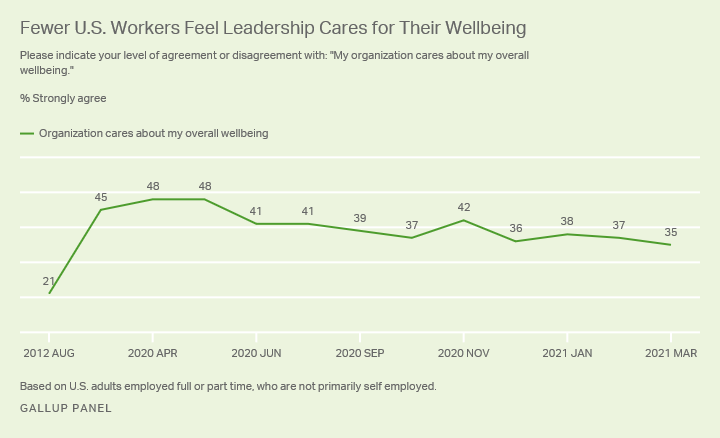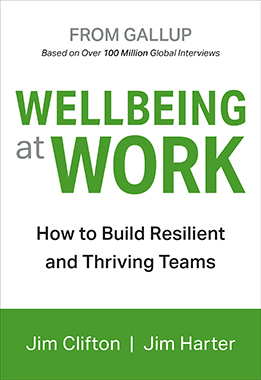Story Highlights
- Workers are losing belief that their employer cares about their wellbeing
- Employers can draw on a returning workforce to reintroduce wellbeing
- Leadership plays a key role in building a wellbeing culture
As the U.S. and its workplaces start to eye post-pandemic normality, there is an urgent need for organizations to press forward with the progress made in employee wellbeing during the COVID-19 era. That's because after increasing to near 50% during the early months of the pandemic, the percentage of employees who strongly agree that their organization cares about their wellbeing has eroded, losing 13 percentage points since last spring.

Line graph depicting what percent of U.S. workers strongly agree with the statement "My organization cares about my overall wellbeing." In August of 2012, 21% strongly agreed. In April and May of 2020, 48% strongly agreed, and most recently in March of 2021, 35% strongly agreed.
With the goodwill banked by employers in the early months of the pandemic now abating, it is more critical than ever that leaders reinvigorate their efforts to build high wellbeing workplaces and cultures.
What follows are 10 critically important best practices for enhancing employee wellbeing in 2021 and beyond.
1. Maintain a strong and sustained leadership voice regarding the importance of wellbeing.
The emphasis on mental health and other aspects of wellbeing during the pandemic cannot be seen as a passing fad. "We're all vaccinated, so we don't have to worry about wellbeing anymore" can't be the message. Rather, organizational leadership needs to communicate this message to its employees regarding a wellbeing culture: "This is who we are, this is important to us, and this is never ever going away."
Wellbeing initiatives that come out of the CEO's office work best. Cultural change is an outcome of the expectations and messages sent by leadership. For example, positive defaults make it easy for employees to do what is in their best interest (things like easy access to healthy cafeteria food, exercise, community activities, financial management, informal social groups). Keep in mind that the five elements of wellbeing (career, social, financial, physical, and community) are interdependent. Programs and practices work best when they target more than one of the five elements.
2. Demonstrate a shared and consistent definition of what is meant by "wellbeing."
Gallup research has shown that wellbeing interventions are more effective -- and greater improvement in wellbeing is realized -- when constituents know precisely what the organization means by "wellbeing." Gallup suggests using the five elements of wellbeing as a science-based organizing structure for all your benefits and wellbeing program offerings.
When you have a wellbeing initiative, align it with at least one of the five elements. Clarify how it builds net thriving and reduces struggling or suffering. When wellbeing opportunities are communicated, use the five element labels so that employees can easily see how everything is organized to improve their days and overall lives.
3. Keep the line of communication constantly open.
Improving and sustaining wellbeing requires that managers stay connected with employees and how their lives are progressing. The single best way to do this is for managers to have conversations with employees -- quick connects and check-ins, with a minimum goal for managers of having one meaningful conversation with each team member per week. Don't forget about the basic elements of managing. Ask employees how any post-pandemic changes going forward may affect their various elements of wellbeing and their performance.
Improving and sustaining wellbeing requires that managers stay connected with employees and how their lives are progressing.
4. Lead by example.
One of the most effective ways to improve wellbeing is to be surrounded by people who are making healthy choices. In an organization, this starts at the top. People often adopt wellbeing practices through social contagion, where peers learn from leaders and one another and live the expected norms. But improvement comes not just from organizational leaders modeling personal behavior. They need to create clear cultural standards in workplaces around how employees eat (are there healthy foods in the cafeteria?), how they move their bodies throughout the day (are employees encouraged by leaders to pursue fitness, even to take walking breaks?), and how they treat one another. Organizations always have an advantage over larger communities when it comes to wellbeing interventions because employees inside organizations are a captive audience.
5. Include family members.
An effective and proven way to demonstrate that the wellbeing of employees is cared for is to show care for their family members, too. As things open back up, big gatherings will become safer -- be they the 5k walks, nutritional cooking classes, retirement planning sessions, volunteering in the community, or strengths workshops for the whole household. Invite and encourage family members to participate. This will promote the wellbeing of employees and their loved ones.
6. Re-promote wellbeing programs and offerings.
Gallup research has shown that only about one-quarter of employees of large employers participate in wellbeing programs and offerings. Never assume that employees are aware of what is available to them. The pending return-to-work period will be a great time to re-energize and reintroduce wellbeing offerings. And, as people feel safer going back to the workplace, they will look at their work environment and its programs with fresh eyes.
7. Scientifically evaluate the effectiveness of wellbeing programs.
It is best practice to continuously audit the use, effectiveness, and value of wellbeing programs in your workplace, including how employees who are participating in the programs report their overall wellbeing changing over time. This practice will be vital in the months ahead as some of the options that were particularly useful during the pandemic -- such as virtual participation -- will likely retreat in importance, while other in-person programs will become more significant again.
Gallup has worked with many organizations to conduct both qualitative and quantitative audits to assess which ones predict higher thriving rates. Every benefit or practice should be held accountable for usefulness and impact.
Here are seven accelerators of net thriving:
- Rules and guidelines: Do they work for or against thriving in each of the five elements?
- Communication: Are your messages, especially from leaders and managers, consistent with a high-performing and net thriving culture?
- Facilities: Is it easy to move around your office space, see the outdoors and collaborate?
- Incentives: Do they inspire participation in activities that drive results?
- Recognition: Do you share and celebrate wellbeing successes?
- Events: Do they build awareness and change behavior?
- Development: Are wellbeing goals included in development plans?
8. Leverage employee engagement to drive employee wellbeing.
Gallup research has demonstrated that the benefits of employee engagement are amplified by employee wellbeing, and that employee engagement is a powerful influencer of future wellbeing. Research has also shown that highly engaged employees are far more likely to feel comfortable talking about wellbeing with their managers.
Because of this, applying employee engagement tactics is an effective way to enhance employee wellbeing as workers return to the workplace and in-person contact resumes. Many common-sense approaches exist to accomplish this, including recognizing employees for wellbeing accomplishments, soliciting their opinions for new programs, and including wellbeing in goal setting.
Organizations need to equip managers to include wellbeing as part of performance management. "Your wellbeing" should be an essential component of the semi-annual review for employees. This does not mean managers play the role of financial adviser, personal trainer or life coach. It does mean that they should integrate wellbeing conversations into their management practice, ongoing conversations, and they need to direct employees to resources that can help them achieve their personal goals.
9. Develop a network of local wellbeing coaches and champions who serve as resources to collect and share best practices.
Organizations need experts, whether they be fitness coaches, financial advisers, nutritionists, community service and volunteer organizers. The end goal is that people have access to the best advice when they need it -- the strongest nudges often come from peers. Every organization has influencers who are gifted at connecting others and encouraging involvement. Find and use your influencers.
Comfortable conversations about wellbeing can only happen when a foundation of trust exists, and wellbeing conversations without that personal connection can be a minefield.
10. Aim strengths at wellbeing.
Changing wellbeing requires changing habits. Comfortable conversations about wellbeing can only happen when a foundation of trust exists, and wellbeing conversations without that personal connection can be a minefield.
Starting wellbeing conversations with an employee's strengths works best because it focuses on the positive contributions of each person, avoids awkward criticism, identifies what makes each person unique, and provides a common language. Each person can identify wellbeing activities via their innate tendencies rather than trying to improve their wellbeing by fundamentally changing who they are. And managers and wellbeing coaches can be equipped to have high-impact, strengths-based wellbeing conversations with some basic structuring.
Also, strengths is a proven accelerator of employee wellbeing and engagement, so a strengths-based approach to enhancing wellbeing is likely to yield additive benefits in performance.
All of this should be evaluated through the lens of the employee experience at each stage of the employee life cycle -- attraction, hiring, onboarding, engaging, performing, developing and departure. Building a thriving wellbeing culture requires all of the ingredients listed above -- and it is within the reach of every organization.
Explore more wellbeing resources:
- Get Gallup's latest book, Wellbeing at Work, for more insights to build resilient and thriving teams.
- Learn more about the connection between wellbeing and performance.
- Discover how to identify burned out employees and prevent further burnout in your organization.





